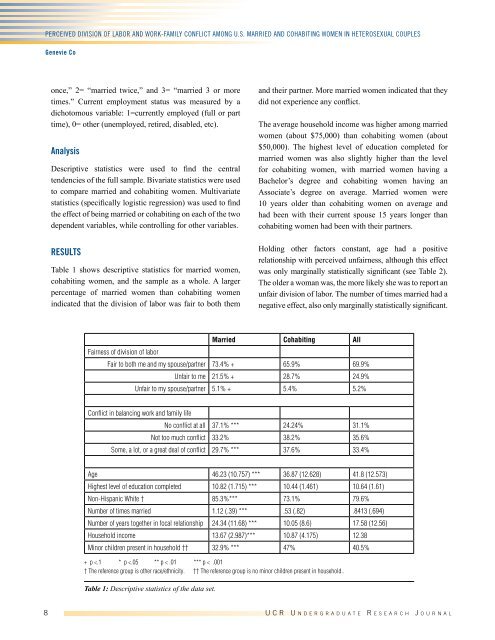Undergraduate Research Journal
Undergraduate Research Journal
Undergraduate Research Journal
Create successful ePaper yourself
Turn your PDF publications into a flip-book with our unique Google optimized e-Paper software.
Perceived Division of Labor and Work-Family Conflict Among U.S. Married and Cohabiting Women in Heterosexual Couples<br />
Genevie Co<br />
once,” 2= “married twice,” and 3= “married 3 or more<br />
times.” Current employment status was measured by a<br />
dichotomous variable: 1=currently employed (full or part<br />
time), 0= other (unemployed, retired, disabled, etc).<br />
Analysis<br />
Descriptive statistics were used to find the central<br />
tendencies of the full sample. Bivariate statistics were used<br />
to compare married and cohabiting women. Multivariate<br />
statistics (specifically logistic regression) was used to find<br />
the effect of being married or cohabiting on each of the two<br />
dependent variables, while controlling for other variables.<br />
RESULTS<br />
Table 1 shows descriptive statistics for married women,<br />
cohabiting women, and the sample as a whole. A larger<br />
percentage of married women than cohabiting women<br />
indicated that the division of labor was fair to both them<br />
and their partner. More married women indicated that they<br />
did not experience any conflict.<br />
The average household income was higher among married<br />
women (about $75,000) than cohabiting women (about<br />
$50,000). The highest level of education completed for<br />
married women was also slightly higher than the level<br />
for cohabiting women, with married women having a<br />
Bachelor’s degree and cohabiting women having an<br />
Associate’s degree on average. Married women were<br />
10 years older than cohabiting women on average and<br />
had been with their current spouse 15 years longer than<br />
cohabiting women had been with their partners.<br />
Holding other factors constant, age had a positive<br />
relationship with perceived unfairness, although this effect<br />
was only marginally statistically significant (see Table 2).<br />
The older a woman was, the more likely she was to report an<br />
unfair division of labor. The number of times married had a<br />
negative effect, also only marginally statistically significant.<br />
Married Cohabiting All<br />
Fairness of division of labor<br />
Fair to both me and my spouse/partner 73.4% + 65.9% 69.9%<br />
Unfair to me 21.5% + 28.7% 24.9%<br />
Unfair to my spouse/partner 5.1% + 5.4% 5.2%<br />
Conflict in balancing work and family life<br />
No conflict at all 37.1% *** 24.24% 31.1%<br />
Not too much conflict 33.2% 38.2% 35.6%<br />
Some, a lot, or a great deal of conflict 29.7% *** 37.6% 33.4%<br />
Age 46.23 (10.757) *** 36.87 (12.628) 41.8 (12.573)<br />
Highest level of education completed 10.82 (1.715) *** 10.44 (1.461) 10.64 (1.61)<br />
Non-Hispanic White † 85.3%*** 73.1% 79.6%<br />
Number of times married 1.12 (.39) *** .53 (.82) .8413 (.694)<br />
Number of years together in focal relationship 24.34 (11.68) *** 10.05 (8.6) 17.58 (12.56)<br />
Household income 13.67 (2.987)*** 10.87 (4.175) 12.38<br />
Minor children present in household †† 32.9% *** 47% 40.5%<br />
+ p














